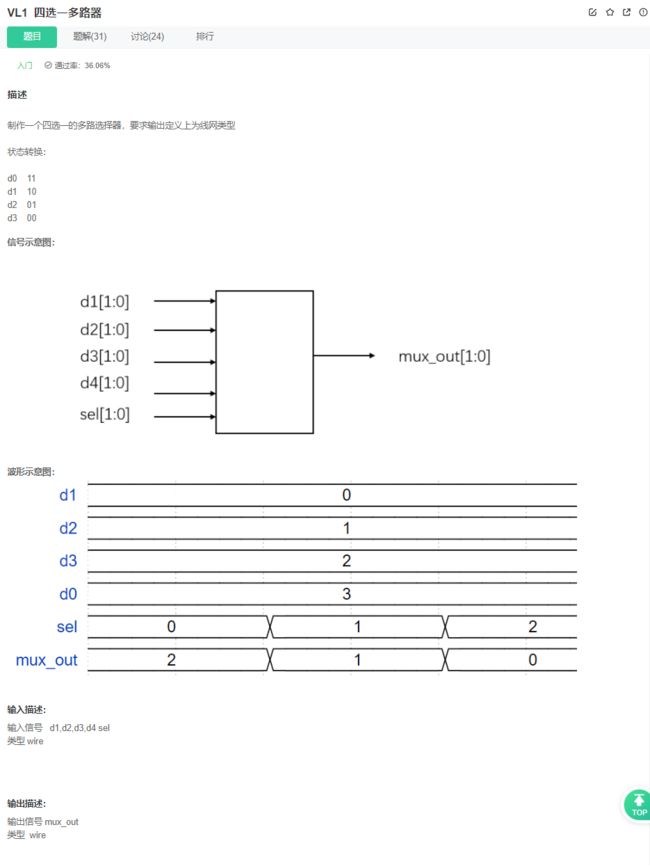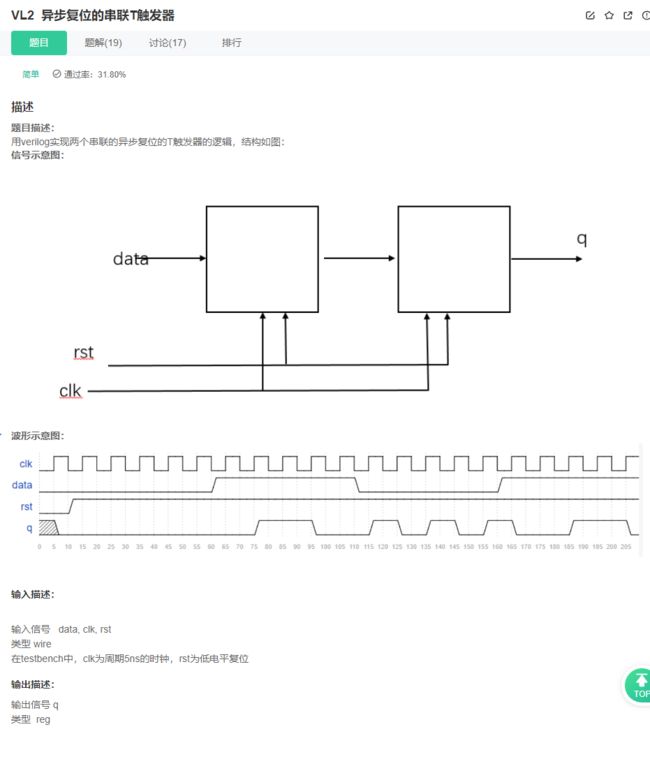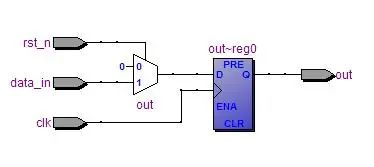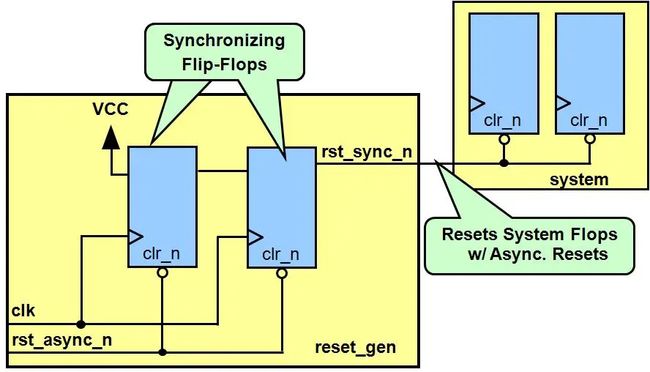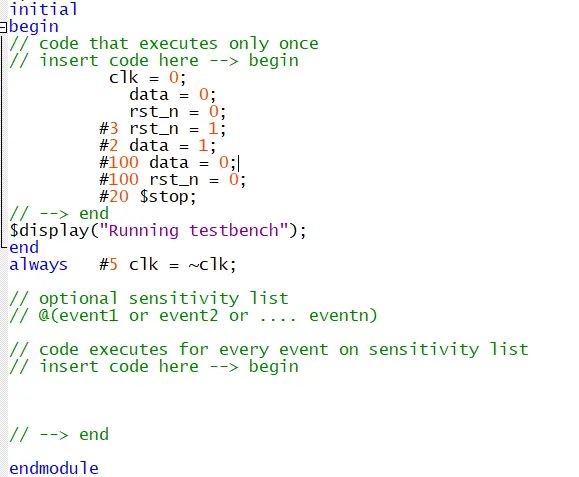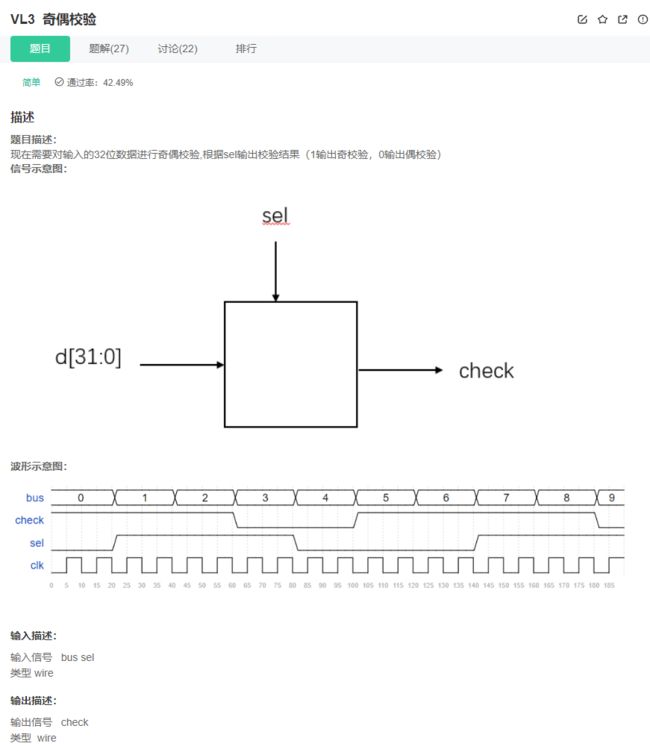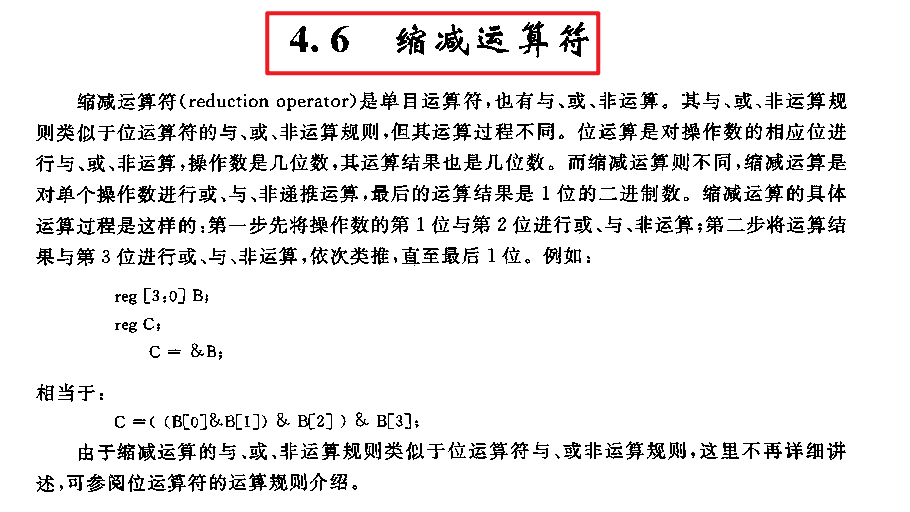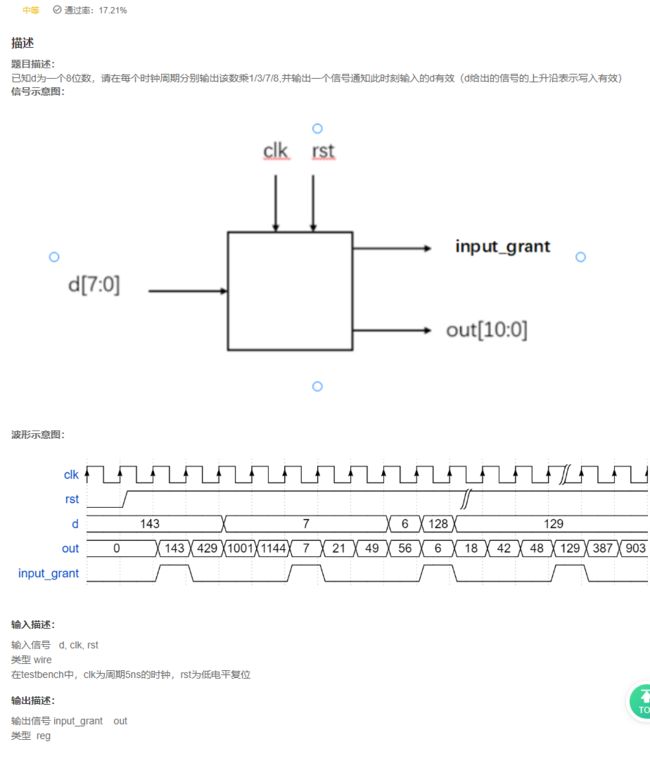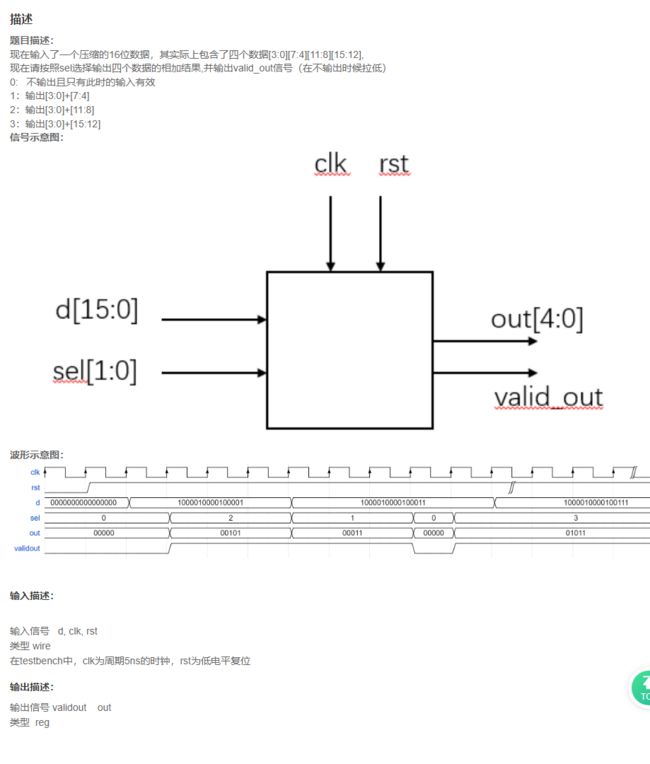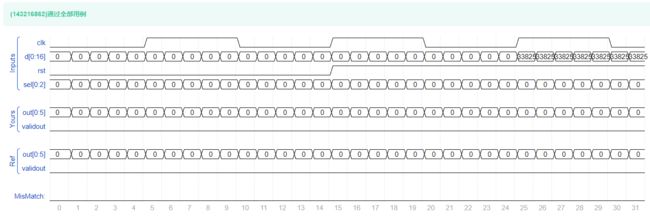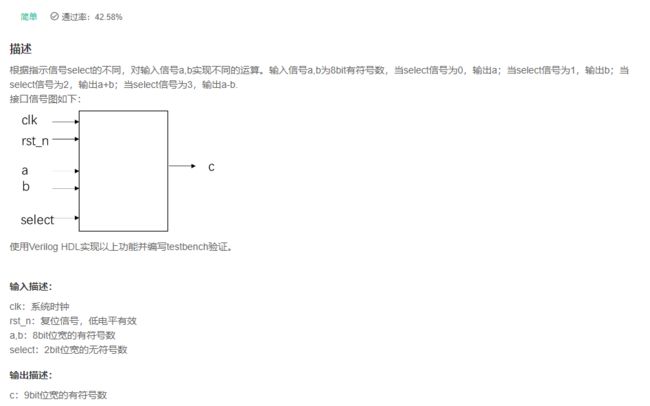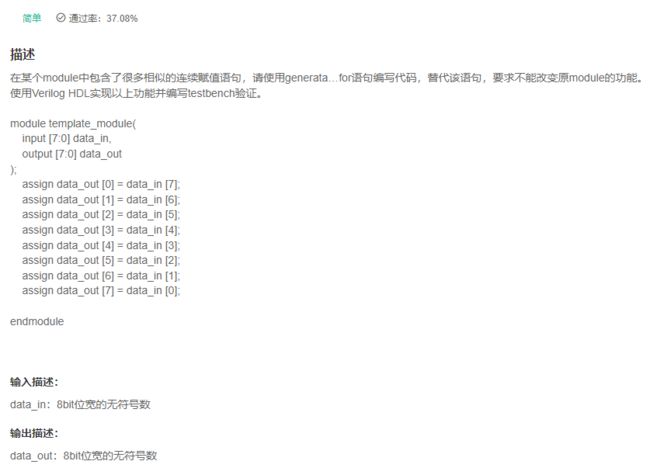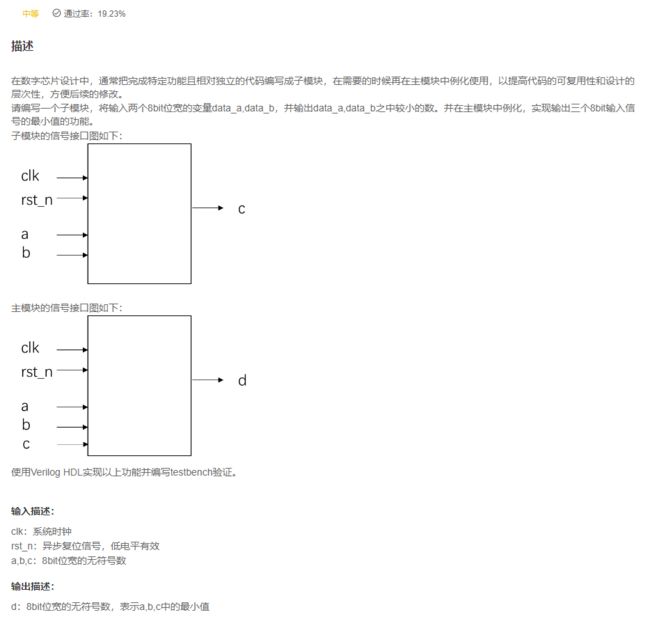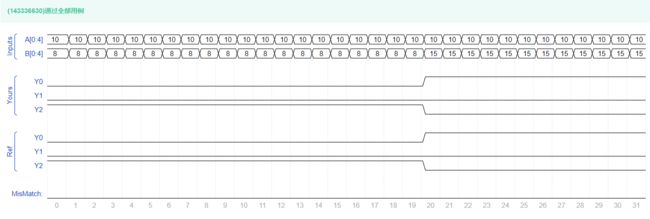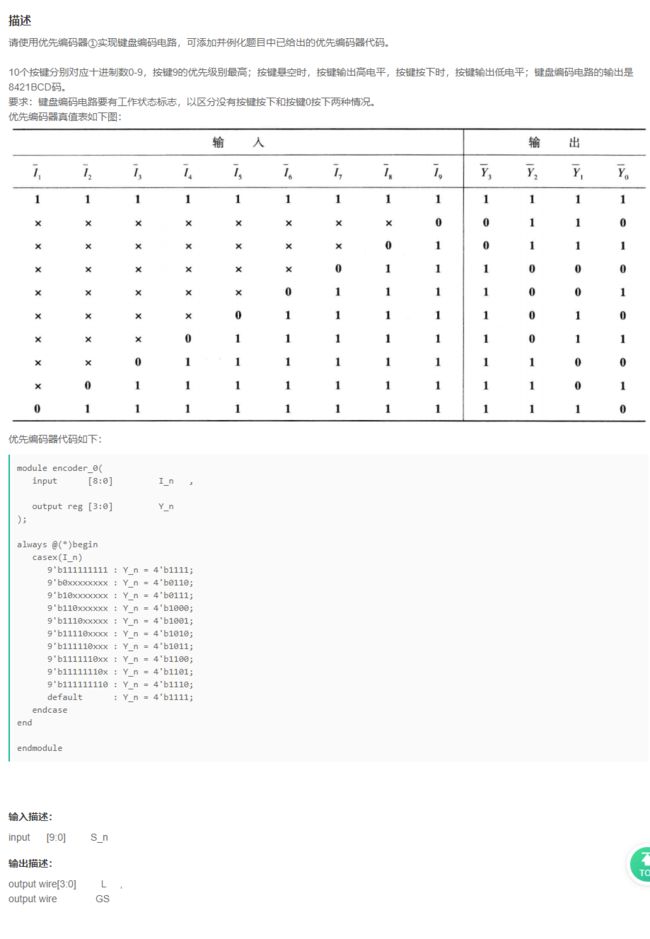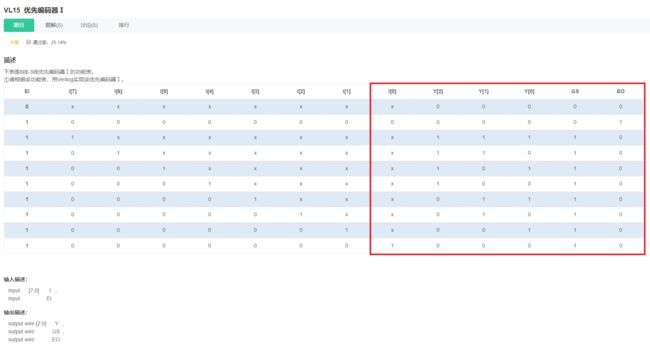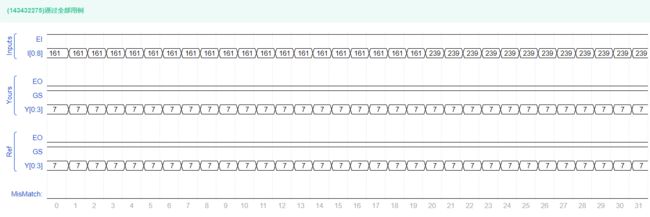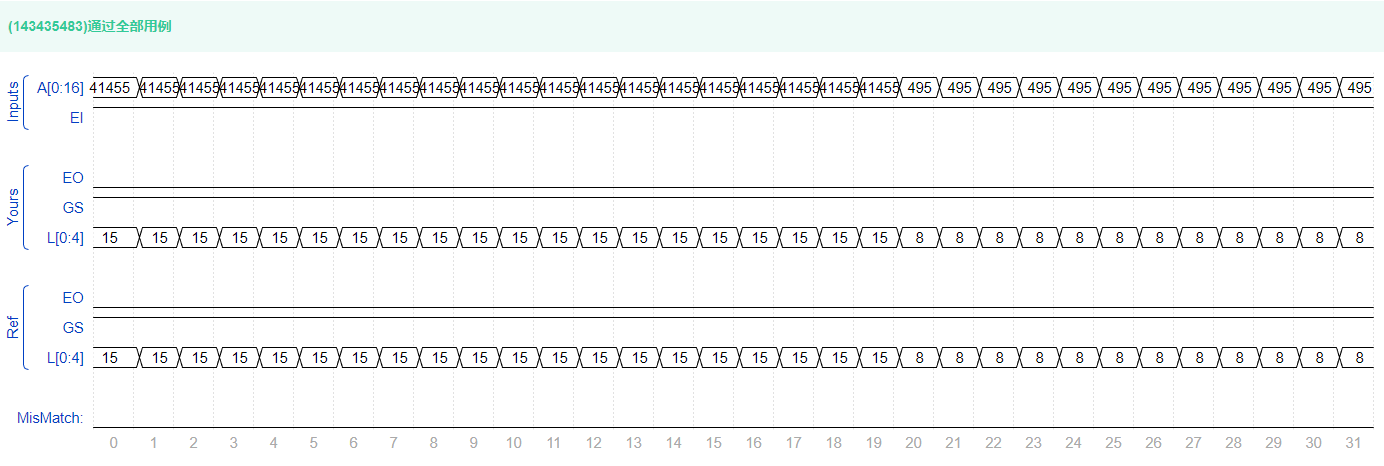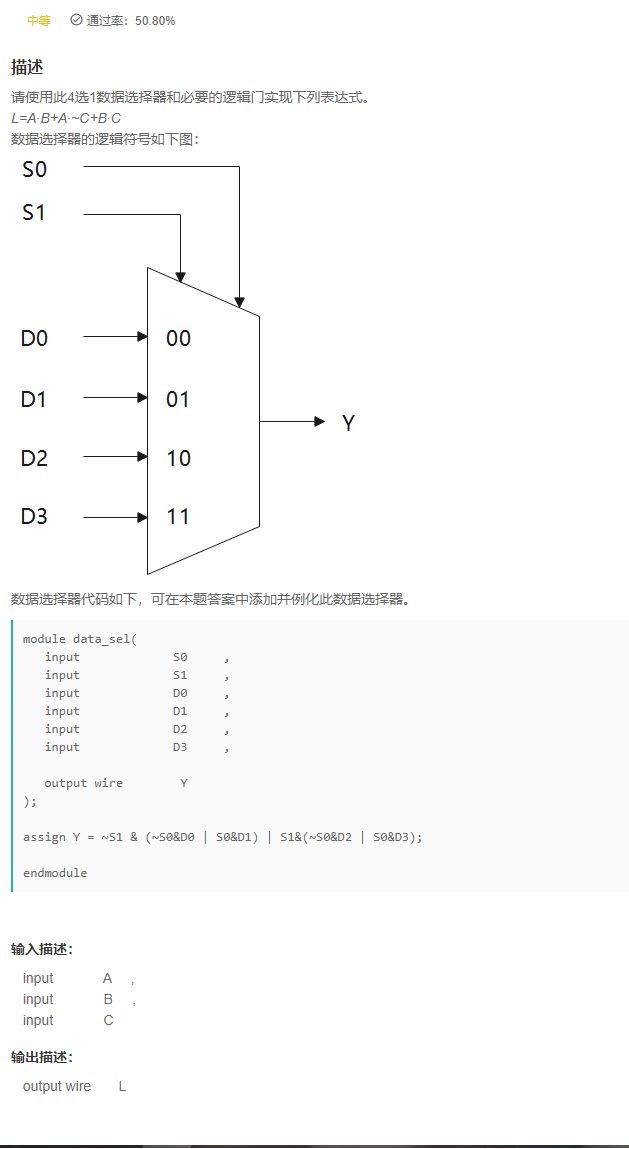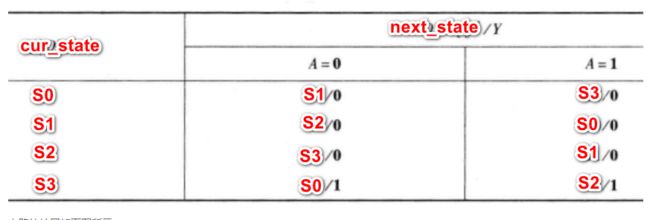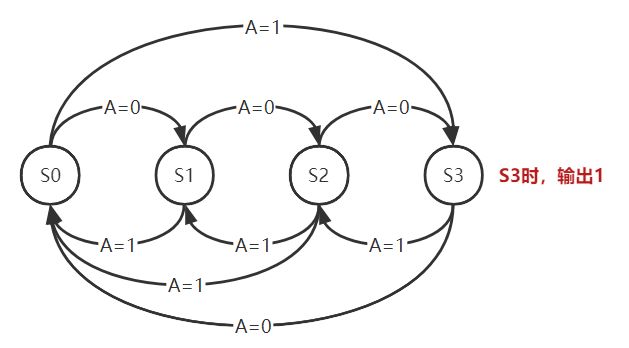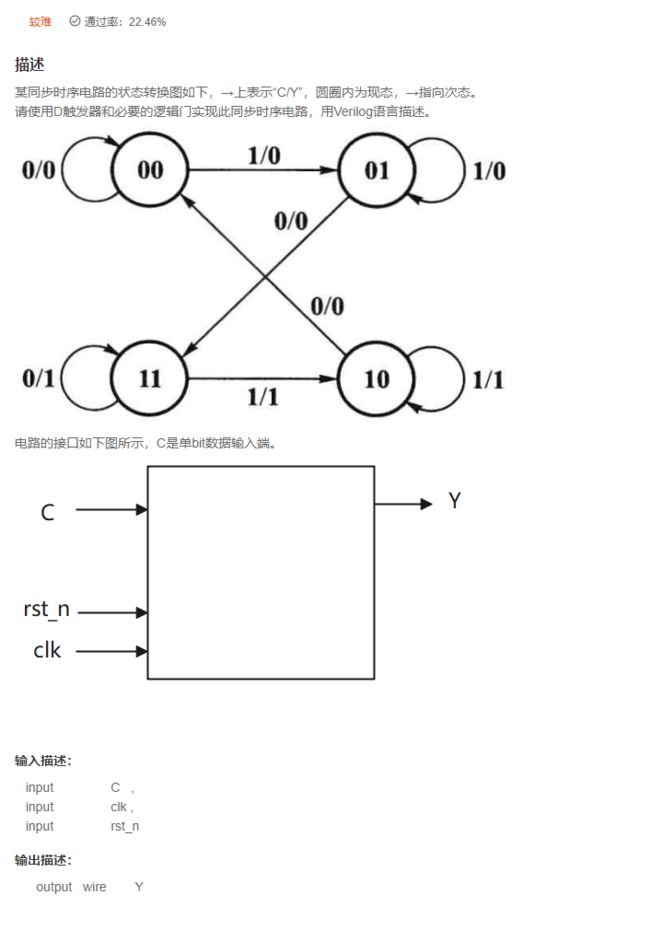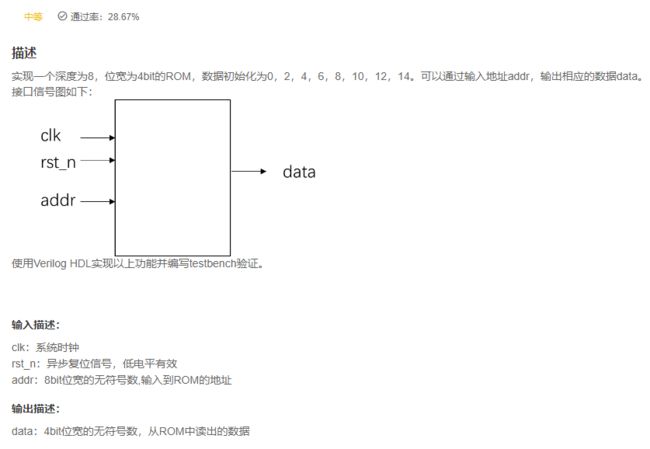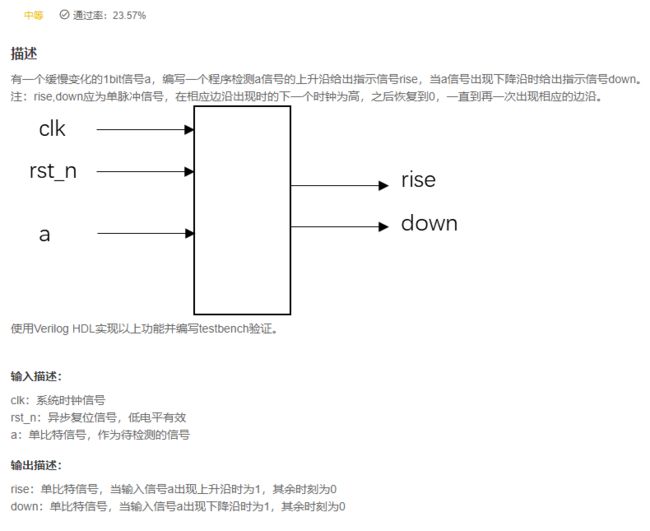《牛客刷verilog》Part I Verilog快速入门
前言
- 之前刷过HDLbits上面的题目,点击链接可以查看详细笔记:verilog练习:hdlbits网站系列完结!
- 最近又想刷一下牛客上面的题目,可以点击链接与小编一起刷题:牛客刷题
- 小编不才,文中如有不当之处,可以在评论中互相交流。此处题目推荐看牛客的评论区,再提一嘴,注意积累自己的基本功
算法、设计模式、软件等
Part I Verilog快速入门
- https://www.nowcoder.com/exam/oj?page=1
01. 基础语法
VL1 四选一多路器
答案
`timescale 1ns/1ns
module mux4_1(
input [1:0]d1,d2,d3,d0,
input [1:0]sel,
output[1:0]mux_out
);
//*************code***********//
reg [1:0] mux_out_reg;
always@(*)begin
case(sel)
2'd0:mux_out_reg = d3;
2'd1:mux_out_reg = d2;
2'd2:mux_out_reg = d1;
// 2'd3:mux_out_reg = d0;
default:mux_out_reg = d0;
endcase
end
assign mux_out = mux_out_reg;
//*************code***********//
endmodule
复盘:
- 选择器最优先想到的就是
case实现,其实这个题目也可以发散思维:如何利用二选一选择器实现四选一?
当sel为11, 输出mux_out为 d0
当sel为10, 输出mux_out为 d1
当sel为01 , 输出mux_out为 d2
当sel为00 , 输出mux_out为 d3
//伪代码表示
if (sel[1] == 1) {
mux_out = sel[0] ? d0:d1;
} else {
mux_out = sel[0] ? d2:d3;
}
- 此时核心代码可以表示为
//*************code***********//
reg [1:0] mux_out_reg;
always@(*)
if (sel[1] == 1)
mux_out_reg = sel[0] ? d0:d1;
else
mux_out_reg = sel[0] ? d2:d3;
assign mux_out = mux_out_reg;
//*************code***********//
- 如果将上述always模块直接去掉,能实现吗?就是把逻辑用两个三目运算符实现了,不推荐。但小编还是想实现一下(因为它只需要一行逻辑):
//*************code***********//
assign mux_out = (sel[1] == 1)?(sel[0] ? d0:d1):(sel[0] ? d2:d3);
//*************code***********//
VL2 异步复位的串联T触发器
答案
`timescale 1ns/1ns
module Tff_2 (
input wire data, clk, rst,
output reg q
);
//*************code***********//
reg tmp;
always@(posedge clk or negedge rst)begin
if (!rst)
tmp <= 1'd0;
else if (data)
tmp <= ~tmp;
else
tmp <= tmp;
end
always@(posedge clk or negedge rst)begin
if (!rst)
q <= 1'd0;
else if (tmp)
q <= ~q;
else
q <= q;
end
//*************code***********//
endmodule
V2异步复位的T串联触发器
分析
- 从上面这张图可以得出:T 触发器的核心要点,来 1 翻转,来 0 保持。
- 根据原理,就很容易得到上面的答案。但是,注意观察真值表,还会得到逻辑表达式:
Q* = T ^ Q,于是可以将核心代码简化:
//*************code***********//
reg tmp;
always@(posedge clk or negedge rst)begin
if (!rst)
tmp <= 1'd0;
else
tmp <= data ^ tmp;
end
always@(posedge clk or negedge rst)begin
if (!rst)
q <= 1'd0;
else
q <= tmp ^ q;
end
//*************code***********//
- 注意思考,T 触发器的核心要点,来 1 翻转,来 0 保持。可以不可以理解为,门控时钟的一种体现?
复盘
注意 T 触发器:来 1 翻转,来 0 保持。
注意理解同步复位和异步复位。
异步复位的缺点:产生毛刺(容易造成亚稳态)
同步复位的缺点:同步复位的电路实现,比异步复位的电路实现,要浪费更多电路资源
关于浪费资源这一点,由于很多fpga自带异步复位,所以同步复位会多增加一个mux
那么结合两者,避免产生亚稳态的同时也充分利用资源,可以采用异步复位同步释放。
常用的异步复位同步释放图:
这里博客中给出了一系列经常容易迷惑的点的解答
1.直接接入异步复位信号驱动复位端有啥问题?
就是常说的异步复位产生亚稳态
2.两级触发器同步,就能消除亚稳态吗?
不能,但能大大减少
3.如果只做一级触发器同步,如何?
不可以。第一级触发器的输出,永远存在亚稳态的可能。亚稳态,导致系统不会复位初始化到已知状态。
当第一级触发器采样异步输入之后,允许输出出现的亚稳态可以长达一个周期,在这个周期内,亚稳态特性减弱。在第二个时钟沿到来时,第二级同步器采样,之后才把该信号传递到内部逻辑中去。第二级输出是稳定且已被同步了的。如果在第二级采样时保持时间不够,第一级的输出仍然处于很强的亚稳态,将会导致第二级同步器也进入亚稳态,但这种故障出现的概率比较小。
4.复位同步器,第2个dff是否存在亚稳态?(这个最让人迷惑)
只有当DFF的数据输入端口和数据输出端口,存在值不同的情况下,才会有recovery timing/removal timing问题。
第1个dff的数据输入端口和数据输出端口,在异步复位释放的时刻,是1和0,所以会有竞争冒险,有概率产生亚稳态;
第2个dff的数据输入端口和数据输出端口,在异步复位释放的时刻,是0和0,所以不存在竞争冒险,不会产生亚稳态。
因为第1个dff有概率产生亚稳态,为了防止传播,所以,多加几级dff,降低亚稳态的传播概率是有益处的。
上面九成问题的答案都转自博客,需要强调的是,现代数字芯片设计,强调的都是同步复位,这样有利于STA(静态时序分析),便于移植。
RTL原理图如下:
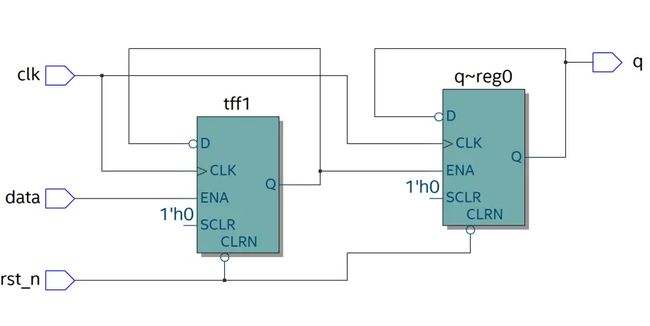
这里Q和D连接我认为可能是逻辑表达式要求和当前状态有关,但说实话,我不清楚这两个模块RTL内部的结构,无法做进一步分析。
测试代码如下:
得到的仿真波形如下:
-
当data为1的时刻,时钟一旦采样到,下一个时钟上升沿则中间输出翻转,而中间输出每两个时钟周期产生一次持续一个周期的高电平,这带来最终输入翻转,每次翻转应该为两个周期一次。且滞后一个周期。
-
当data为0的时候,若中间输出为一,最终输出继续翻转,若为零,保持不变(波形仅仅涵盖第二种结果。
VL3 奇偶校验
答案
`timescale 1ns/1ns
module odd_sel(
input [31:0] bus,
input sel,
output check
);
//*************code***********//
assign check = sel ? (^bus) : ~(^bus);
//*************code***********//
endmodule
分析
1、奇偶校验,通过校验位使得1的个数恰好是奇数个或偶数个
奇校验:原始码流+校验位 总共有奇数个1
偶校验:原始码流+校验位 总共有偶数个1
说人话,
对于奇校验,如果原始码流中1的个数是偶数个,那么校验位就是1, 否则就是0;
对于奇校验,如果原始码流中1的个数是奇数个,那么校验位就是0, 否则就是1;
对于偶校验,如果原始码流中1的个数是偶数个,那么校验位就是0, 否则就是1;
对于偶校验,如果原始码流中1的个数是奇数个,那么校验位就是1, 否则就是0;
2、判断原始码流中的1的个数是偶数个还是奇数个
- 此处很容易想到异或操作,
0011_1111_1111_1111按位异或得到的值是1,此时的1就是奇校验位;如果求偶校验位,取反即可
3、写出伪代码如下:
if (sel == 1)//求奇校验
check = ^bus;
else
check = ~(^bus);
- 此时很容易想到三目运算符写答案:
assign check = sel ? (^bus) : ~(^bus);
复盘
VL4 移位运算与乘法
答案
`timescale 1ns/1ns
module multi_sel(
input [7:0]d ,
input clk,
input rst,
output reg input_grant,
output reg [10:0]out
);
//*************code***********//
reg[1:0] cnt_4;
always@(posedge clk or negedge rst)begin
if(!rst)
cnt_4 <= 'd0;
else if(cnt_4 == 2'b11)
cnt_4 <= 'd0;
else cnt_4 <= cnt_4 + 1'b1;
end
reg [7:0] d_reg;
always@(posedge clk or negedge rst)begin
if(!rst)begin
input_grant <= 'b0;
out <= 'd0;
end
else if(cnt_4 == 'd0)begin
input_grant <= 'b1;
d_reg <= d;
out <= d;
end
else if(cnt_4 == 'd1)begin
input_grant <= 'b0;
out <= d_reg * 3;
end
else if(cnt_4 == 'd2)begin
input_grant <= 'b0;
out <= d_reg * 7;
end
else if(cnt_4 == 'd3)begin
input_grant <= 'b0;
out <= d_reg * 8;
end
end
//*************code***********//
endmodule
复盘
- 题目中明确给出了四拍处理一个输入,很常见的就是设置一个计数器,用两位的计数器就可以统计四个状态,
也不用自己计数清零了。 - 上述的使用了带有优先级的
if -else结构,可以优化为case结构,小编就不改写这部分了,下一题用到了case结构。 - 上面的信号可以单独分开书写,优化效果如下:
//*************code***********//
reg[1:0] cnt_4;
always@(posedge clk or negedge rst)begin
if(!rst)
cnt_4 <= 'd0;
else
cnt_4 <= cnt_4 + 1'b1;
end
reg [7:0] d_reg;
always@(posedge clk or negedge rst)begin
if(!rst)begin
input_grant <= 'b0;
out <= 'd0;
end
else if(cnt_4 == 'd0)begin
d_reg <= d;
out <= d;
end
else if(cnt_4 == 'd1)begin
out <= d_reg * 3;
end
else if(cnt_4 == 'd2)begin
out <= d_reg * 7;
end
else if(cnt_4 == 'd3)begin
out <= d_reg * 8;
end
end
always@(posedge clk or negedge rst)begin
if(!rst)begin
input_grant <= 'b0;
end
else if(cnt_4 == 'd0)begin
input_grant <= 'b1;
end
else begin
input_grant <= 'b0;
end
end
//*************code***********//
VL5 位拆分与运算
答案
`timescale 1ns/1ns
module data_cal(
input clk,
input rst,
input [15:0]d,
input [1:0]sel,
output [4:0]out,
output validout
);
//*************code***********//
reg validout;
always @ (posedge clk or negedge rst)begin
if (!rst)begin
validout <= 1'b0;
end
else if (sel == 2'b0) begin
validout <= 1'b0;
end else begin
validout <= 1'b1;
end
end
reg [15:0] d_reg;
always @ (posedge clk or negedge rst)begin
if (!rst)begin
d_reg <= 'd0;
end
else if (sel == 0)begin
d_reg <= d;
end
// else begin
// d_reg <= d_reg;
// end
end
reg [4:0]out;
always @ (posedge clk or negedge rst)begin
if (!rst)begin
out <= 'd0;
end
else case(sel)
2'b00:out <= 'd0;
2'b01:out <= d_reg[3:0] + d_reg[7:4];
2'b10:out <= d_reg[3:0] + d_reg[11:8];
2'b11:out <= d_reg[3:0] + d_reg[15:12];
endcase
end
//*************code***********//
endmodule
复盘
- 注意思考
d_reg的作用,这个信号究竟起着什么作用,还有注释掉的三行代码在工程实践中是否可以完全省略? case 结构怎么与if-else结构互换?
VL6 多功能数据处理器
答案
`timescale 1ns/1ns
module data_select(
input clk,
input rst_n,
input signed[7:0]a,
input signed[7:0]b,
input [1:0]select,
output reg signed [8:0]c
);
always@(posedge clk or negedge rst_n)begin
if (!rst_n)
c <= 'd0;
else case(select)
2'b00:c <= a;
2'b01:c <= b;
2'b10:c <= a+b;
2'b11:c <= a-b;
endcase
end
endmodule
复盘
- 有没有觉得和上面几道题思路完全一致
VL7 求两个数的差值
答案
`timescale 1ns/1ns
module data_minus(
input clk,
input rst_n,
input [7:0]a,
input [7:0]b,
output reg [8:0]c
);
always@(posedge clk or negedge rst_n)
if (!rst_n)
c <= 'd0;
else
c <= (a > b) ? (a - b) : (b-a);
endmodule
VL8 使用generate…for语句简化代码
答案
`timescale 1ns/1ns
module gen_for_module(
input [7:0] data_in,
output [7:0] data_out
);
genvar i;
generate for( i = 0; i < 8; i = i + 1 )
// begin:generate_1
assign data_out [i] = data_in [7 - i];
// end
endgenerate
endmodule
复盘
- 下面是别人写的笔记,请看小编上面的答案,还故意把第2条信息给违背了?
WHY?想必你可以自行判断正误
- 还有注意第一条为什么需要满足?个人觉得可以结合
动态变量进行理解!
VL9 使用子模块实现三输入数的大小比较
答案
`timescale 1ns/1ns
module main_mod(
input clk,
input rst_n,
input [7:0]a,
input [7:0]b,
input [7:0]c,
output [7:0]d
);
wire [7:0] min1, min2;
min_mod min1_mod(
.clk(clk),
.rst_n(rst_n),
.a(a),
.b(b),
.min(min1)
);
min_mod min2_mod(
.clk(clk),
.rst_n(rst_n),
.a(a),
.b(c),
.min(min2)
);
min_mod min3_mod(
.clk(clk),
.rst_n(rst_n),
.a(min1),
.b(min2),
.min(d)
);
// assign d = min1 > min2 ? min2 : min1;
endmodule
module min_mod(
input clk,
input rst_n,
input [7:0]a,
input [7:0]b,
output reg [7:0]min
);
always@(posedge clk or negedge rst_n)
if(!rst_n)
min <= 'd0;
else
min <= (a > b) ? b : a;
endmodule
复盘
- 题目中要求使用子模块进行大小比较
- 注意时序要求:本想着节约一拍的时间,就写成了如下的形式,给报错了。
`timescale 1ns/1ns
module main_mod(
input clk,
input rst_n,
input [7:0]a,
input [7:0]b,
input [7:0]c,
output [7:0]d
);
wire [7:0] min1, min2;
min_mod min1_mod(
.clk(clk),
.rst_n(rst_n),
.a(a),
.b(b),
.min(min1)
);
min_mod min2_mod(
.clk(clk),
.rst_n(rst_n),
.a(a),
.b(c),
.min(min2)
);
// min_mod min3_mod(
// .clk(clk),
// .rst_n(rst_n),
// .a(min1),
// .b(min2),
// .min(d)
// );
assign d = min1 > min2 ? min2 : min1;
endmodule
module min_mod(
input clk,
input rst_n,
input [7:0]a,
input [7:0]b,
output reg [7:0]min
);
always@(posedge clk or negedge rst_n)
if(!rst_n)
min <= 'd0;
else
min <= (a > b) ? b : a;
endmodule
VL10 使用函数实现数据大小端转换
答案
`timescale 1ns/1ns
module function_mod(
input clk,
input rst_n,
input [3:0]a,
input [3:0]b,
output [3:0]c,
output [3:0]d
);
function [3:0] reverse;
input [3:0] data_in;
begin
reverse[0] = data_in[3];
reverse[1] = data_in[2];
reverse[2] = data_in[1];
reverse[3] = data_in[0];
end
endfunction
assign c = reverse(a);
assign d = reverse(b);
endmodule
复盘
- 不想过多的解释,题目中原始端口竟然没有
clk和rst_n,而且题目中还说,c和d都是8bit的。。。 - 大小端,是针对字节序而言的。此题可以说是比特位反转,再说,这一功能用
流操作一行代码就可以搞定,设计人员赶快学学systemverilog。
02. 组合逻辑
- https://www.nowcoder.com/exam/oj?page=1
VL11 4位数值比较器电路
答案
`timescale 1ns/1ns
module comparator_4(
input [3:0] A ,
input [3:0] B ,
output reg Y2 , //A>B
output reg Y1 , //A=B
output reg Y0 //A
);
always@(*)begin
if (A[3] > B[3])
{Y2,Y1,Y0} = 3'b100;
else if (A[3] < B[3])
{Y2,Y1,Y0} = 3'b001;
else if (A[2] > B[2])
{Y2,Y1,Y0} = 3'b100;
else if (A[2] < B[2])
{Y2,Y1,Y0} = 3'b001;
else if (A[1] > B[1])
{Y2,Y1,Y0} = 3'b100;
else if (A[1] < B[1])
{Y2,Y1,Y0} = 3'b001;
else if (A[0] > B[0])
{Y2,Y1,Y0} = 3'b100;
else if (A[0] < B[0])
{Y2,Y1,Y0} = 3'b001;
else
{Y2,Y1,Y0} = 3'b010;
end
endmodule
复盘
- 上面全部使用了
if-else这种结构,它存在优先级关系,个人看来也是最容易理解的一种方式。 - 在实际项目中,并不是一下子就写出很稳健的程序,后期就是不断的优化,利用各种各样先进的算法、甚至加入设计模式来优化。
- 上面题目答案,我将接口定义的输出端口由
wire类型改为了reg类型,为什么呢?(自己想,就是不想打字了) - 接下面再将输出一致的情况合并,代码如下:
`timescale 1ns/1ns
module comparator_4(
input [3:0] A ,
input [3:0] B ,
output reg Y2 , //A>B
output reg Y1 , //A=B
output reg Y0 //A
);
always@(*)begin
if ((A[3] > B[3]) || ((A[3] == B[3]) && (A[2] > B[2])) || ((A[3] == B[3]) && (A[2] == B[2]) && (A[1] > B[1])) || ((A[3] == B[3]) && (A[2] == B[2]) && (A[1] == B[1]) && (A[0] > B[0])))
{Y2,Y1,Y0} = 3'b100;
else if ((A[3] < B[3]) || ((A[3] == B[3]) && (A[2] < B[2])) || ((A[3] == B[3]) && (A[2] == B[2]) && (A[1] < B[1])) || ((A[3] == B[3]) && (A[2] == B[2]) && (A[1] == B[1]) && (A[0] < B[0])))
{Y2,Y1,Y0} = 3'b001;
else
{Y2,Y1,Y0} = 3'b010;
end
endmodule
- 基于上述代码,继续优化,变量默认初始值都是0,我们只需要关注什么时候产生1,于是继续优化,代码如下:
`timescale 1ns/1ns
module comparator_4(
input [3:0] A ,
input [3:0] B ,
output reg Y2 , //A>B
output reg Y1 , //A=B
output reg Y0 //A
);
always@(*)begin
Y2 = ((A[3] > B[3]) || ((A[3] == B[3]) && (A[2] > B[2])) || ((A[3] == B[3]) && (A[2] == B[2]) && (A[1] > B[1])) || ((A[3] == B[3]) && (A[2] == B[2]) && (A[1] == B[1]) && (A[0] > B[0]))) ? 1'b1 : 1'b0;
Y0 = ((A[3] < B[3]) || ((A[3] == B[3]) && (A[2] < B[2])) || ((A[3] == B[3]) && (A[2] == B[2]) && (A[1] < B[1])) || ((A[3] == B[3]) && (A[2] == B[2]) && (A[1] == B[1]) && (A[0] < B[0]))) ? 1'b1 : 1'b0;
Y1 = ((A[3] == B[3]) && (A[2] == B[2]) && (A[1] == B[1]) && (A[0] == B[0])) ? 1'b1 : 1'b0;
end
endmodule
- 继续优化,Y1的逻辑可以简写成这样
Y1 = (A == B) ? 1'b1 : 1'b0;,甚至直接写成Y1 = A == B;还有三者的变量不同时为1,所以除Y1的变量可以写成其他两个变量取反
`timescale 1ns/1ns
module comparator_4(
input [3:0] A ,
input [3:0] B ,
output reg Y2 , //A>B
output reg Y1 , //A=B
output reg Y0 //A
);
always@(*)begin
Y2 = (A[3] > B[3]) || ((A[3] == B[3]) && (A[2] > B[2])) || ((A[3] == B[3]) && (A[2] == B[2]) && (A[1] > B[1])) || ((A[3] == B[3]) && (A[2] == B[2]) && (A[1] == B[1]) && (A[0] > B[0]));
Y1 = A == B;
Y0 = ~(Y2 || Y1);
end
endmodule
- 此时此刻, 突然想把输出端口的reg类型改为原来的wire类型,那我们需要用assign语句了,继续改造,但是报错了,小编并不觉得错了,如果发现了错误可以在评论区指出来哈。
`timescale 1ns/1ns
module comparator_4(
input [3:0] A ,
input [3:0] B ,
output wire Y2 , //A>B
output wire Y1 , //A=B
output wire Y0 //A
);
assign Y1 = A == B;
assign Y2 = (A[3] > B[3]) || ((A[3] == B[3]) && (A[2] > B[2])) || ((A[3] == B[3]) && (A[2] == B[2]) && (A[1] > B[1])) || ((A[3] == B[3]) && (A[2] == B[2]) && (A[1] == B[1]) && (A[0] > B[0]));
assign Y0 = ~(Y2 || Y1);
endmodule
VL12 4bit超前进位加法器电路
答案
`timescale 1ns/1ns
module lca_4(
input [3:0] A_in ,
input [3:0] B_in ,
input C_1 ,
output wire CO ,
output wire [3:0] S
);
wire [3:0] G;
wire [3:0] P;
assign G[0] = A_in[0] & B_in[0];
assign G[1] = A_in[1] & B_in[1];
assign G[2] = A_in[2] & B_in[2];
assign G[3] = A_in[3] & B_in[3];
assign P[0] = A_in[0] ^ B_in[0];
assign P[1] = A_in[1] ^ B_in[1];
assign P[2] = A_in[2] ^ B_in[2];
assign P[3] = A_in[3] ^ B_in[3];
wire [3:0] C;
assign S[0] = P[0] ^ C_1;
assign S[1] = P[1] ^ C[0];
assign S[2] = P[2] ^ C[1];
assign S[3] = P[3] ^ C[2];
assign CO = C[3];
assign C[0] = G[0] | P[0]&C_1;
assign C[1] = G[1] | P[1]&C[0];
assign C[2] = G[2] | P[2]&C[1];
assign C[3] = G[3] | P[3]&C[2];
endmodule
复盘
- 此处推荐一篇文章3-2 Verilog 4位行波进位加法器,还有可以了解一下
行波进位(Ripple Carry)与超前进位(Loodahead Carry) - 刚开始学习的时候就很迷糊,这部分就不展开胡说了。
VL13 优先编码器电路①
答案
`timescale 1ns/1ns
module encoder_0(
input [8:0] I_n ,
output reg [3:0] Y_n
);
always @ (*)
begin
casex(I_n)
9'b1_1111_1111 : Y_n = 4'b1111;
9'b0_xxxx_xxxx : Y_n = 4'b0110;
9'b1_0xxx_xxxx : Y_n = 4'b0111;
9'b1_10xx_xxxx : Y_n = 4'b1000;
9'b1_110x_xxxx : Y_n = 4'b1001;
9'b1_1110_xxxx : Y_n = 4'b1010;
9'b1_1111_0xxx : Y_n = 4'b1011;
9'b1_1111_10xx : Y_n = 4'b1100;
9'b1_1111_110x : Y_n = 4'b1101;
9'b1_1111_1110 : Y_n = 4'b1110;
default : Y_n = 4'b1111;
endcase
end
endmodule
复盘
- 答案已经在下一题给出了,哈哈哈
VL14 用优先编码器①实现键盘编码电路
答案
`timescale 1ns/1ns
module encoder_0(
input [8:0] I_n ,
output reg [3:0] Y_n
);
always @(*)begin
casex(I_n)
9'b111111111 : Y_n = 4'b1111;
9'b0xxxxxxxx : Y_n = 4'b0110;
9'b10xxxxxxx : Y_n = 4'b0111;
9'b110xxxxxx : Y_n = 4'b1000;
9'b1110xxxxx : Y_n = 4'b1001;
9'b11110xxxx : Y_n = 4'b1010;
9'b111110xxx : Y_n = 4'b1011;
9'b1111110xx : Y_n = 4'b1100;
9'b11111110x : Y_n = 4'b1101;
9'b111111110 : Y_n = 4'b1110;
default : Y_n = 4'b1111;
endcase
end
endmodule
module key_encoder(
input [9:0] S_n ,
output wire[3:0] L ,
output wire GS
);
wire [3:0] Y_n;
encoder_0 encoder(
.I_n (S_n[9:1]),
.Y_n (Y_n)
);
assign L = ~Y_n;
// assign GS = ~(S_n[0] & Y_n[0] & Y_n[1] & Y_n[2] & Y_n[3]);
assign GS = ((Y_n == 4'b1111) && (S_n[0] == 1)) ? 0 : 1;
endmodule
VL15 优先编码器Ⅰ
答案
`timescale 1ns/1ns
module encoder_83(
input [7:0] I ,
input EI ,
output wire [2:0] Y ,
output wire GS ,
output wire EO
);
reg [4:0] temp;
assign {Y[2:0],GS,EO} = temp;
always@(*) begin
casex({EI,I[7:0]})
9'b0_xxxx_xxxx: temp = 5'b000_00;
9'b1_0000_0000: temp = 5'b000_01;
9'b1_1xxx_xxxx: temp = 5'b111_10;
9'b1_01xx_xxxx: temp = 5'b110_10;
9'b1_001x_xxxx: temp = 5'b101_10;
9'b1_0001_xxxx: temp = 5'b100_10;
9'b1_0000_1xxx: temp = 5'b011_10;
9'b1_0000_01xx: temp = 5'b010_10;
9'b1_0000_001x: temp = 5'b001_10;
9'b1_0000_0001: temp = 5'b000_10;
endcase
end
endmodule
复盘
- 这种译码器最简单的实现方式就是,你把码表直接实现一遍即可。
- 比如,这部分的数字和题目中的完全一致
9'b0_xxxx_xxxx: temp = 5'b000_00;
9'b1_0000_0000: temp = 5'b000_01;
9'b1_1xxx_xxxx: temp = 5'b111_10;
9'b1_01xx_xxxx: temp = 5'b110_10;
9'b1_001x_xxxx: temp = 5'b101_10;
9'b1_0001_xxxx: temp = 5'b100_10;
9'b1_0000_1xxx: temp = 5'b011_10;
9'b1_0000_01xx: temp = 5'b010_10;
9'b1_0000_001x: temp = 5'b001_10;
9'b1_0000_0001: temp = 5'b000_10;
- 当然,还有其他实现方式,比如下题中给出的就是
VL16 使用8线-3线优先编码器Ⅰ实现16线-4线优先编码器
答案
`timescale 1ns/1ns
module encoder_83(
input [7:0] I ,
input EI ,
output wire [2:0] Y ,
output wire GS ,
output wire EO
);
assign Y[2] = EI & (I[7] | I[6] | I[5] | I[4]);
assign Y[1] = EI & (I[7] | I[6] | ~I[5]&~I[4]&I[3] | ~I[5]&~I[4]&I[2]);
assign Y[0] = EI & (I[7] | ~I[6]&I[5] | ~I[6]&~I[4]&I[3] | ~I[6]&~I[4]&~I[2]&I[1]);
assign EO = EI&~I[7]&~I[6]&~I[5]&~I[4]&~I[3]&~I[2]&~I[1]&~I[0];
assign GS = EI&(I[7] | I[6] | I[5] | I[4] | I[3] | I[2] | I[1] | I[0]);
//assign GS = EI&(| I);
endmodule
module encoder_164(
input [15:0] A ,
input EI ,
output wire [3:0] L ,
output wire GS ,
output wire EO
);
wire [2:0] Y_1,Y_0;
wire gs_1,gs_0;
wire EO1;
encoder_83 encoder_83_U1(
.I (A[15:8]),
.EI (EI),
.Y (Y_1),
.GS (gs_1),
.EO (EO1)
);
encoder_83 encoder_83_U0(
.I (A[7:0]),
.EI (EO1),
.Y (Y_0),
.GS (gs_0),
.EO (EO)
);
assign L = {gs_1,Y_1[2]|Y_0[2],Y_1[1]|Y_0[1],Y_1[0]|Y_0[0]};
assign GS = gs_1|gs_0;
endmodule
复盘
- 抄的,题目晦涩难懂
VL17 用3-8译码器实现全减器
答案
- 不想做,题目截图,防止后期题库更新就截图当快照了
VL18 实现3-8译码器①
中等 通过率:37.98%
描述
下表是74HC138译码器的功能表
①请用基础门电路实现该译码器电路,用Verilog将电路描述出来。基础门电路包括:非门、多输入与门、多输入或门。

输入描述:
input E1_n ,
input E2_n ,
input E3 ,
input A0 ,
input A1 ,
input A2
输出描述:
output wire Y0_n ,
output wire Y1_n ,
output wire Y2_n ,
output wire Y3_n ,
output wire Y4_n ,
output wire Y5_n ,
output wire Y6_n ,
output wire Y7_n
答案
- 不想做,题目截图,防止后期题库更新就截图当快照了
VL19 使用3-8译码器①实现逻辑函数
- 略
VL20 数据选择器实现逻辑电路
答案
`timescale 1ns/1ns
module data_sel(
input S0 ,
input S1 ,
input D0 ,
input D1 ,
input D2 ,
input D3 ,
output wire Y
);
assign Y = ~S1 & (~S0&D0 | S0&D1) | S1&(~S0&D2 | S0&D3);
endmodule
module sel_exp(
input A ,
input B ,
input C ,
output wire L
);
data_sel u(
.S1('b0),
.S0(C),
.D1(B),
.D0(A),
.Y(L)
);
endmodule
03. 时序逻辑
- https://www.nowcoder.com/exam/oj?page=1
VL21 根据状态转移表实现时序电路
答案
`timescale 1ns/1ns
module seq_circuit(
input A ,
input clk ,
input rst_n,
output wire Y
);
reg [1:0] cur_state,next_state;
reg Y_temp;
assign Y=Y_temp;
parameter S0=2'b00;
parameter S1=2'b01;
parameter S2=2'b10;
parameter S3=2'b11;
always@(posedge clk or negedge rst_n)begin
if(~rst_n)
cur_state<=S0;
else
cur_state<=next_state;
end
always@(*)begin
case(cur_state)
S0:begin
if(A==0)
next_state=S1;
else
next_state=S3;
end
S1:begin
if(A==0)
next_state=S2;
else
next_state=S0;
end
S2:begin
if(A==0)
next_state=S3;
else
next_state=S1;
end
S3:begin
if(A==0)
next_state=S0;
else
next_state=S2;
end
default:next_state=S0;
endcase
end
always@(*)begin
if(cur_state==S3)
Y_temp=1;
else
Y_temp=0;
end
endmodule
复盘
VL22 根据状态转移图实现时序电路
答案
`timescale 1ns/1ns
module seq_circuit(
input C ,
input clk ,
input rst_n,
output wire Y
);
reg [1:0] cur_state,next_state;
reg Y_temp;
assign Y=Y_temp;
parameter S0=2'b00;
parameter S1=2'b01;
parameter S2=2'b10;
parameter S3=2'b11;
always@(posedge clk or negedge rst_n)begin
if(~rst_n)
cur_state<=S0;
else
cur_state<=next_state;
end
always@(*)begin
case(cur_state)
S0:begin
if(C==0)
next_state=S0;
else
next_state=S1;
end
S1:begin
if(C==0)
next_state=S3;
else
next_state=S1;
end
S2:begin
if(C==0)
next_state=S0;
else
next_state=S2;
end
S3:begin
if(C==0)
next_state=S3;
else
next_state=S2;
end
default:next_state=S0;
endcase
end
always@(*)begin
if(cur_state==S3 || (cur_state==S2 && C == 1))
Y_temp=1;
else
Y_temp=0;
end
endmodule
复盘
- 直接修改上一题的代码就可以
VL23 ROM的简单实现
答案
`timescale 1ns/1ns
module rom(
input clk,
input rst_n,
input [7:0]addr,
output [3:0]data
);
reg [3:0] romreg[7:0];
always @ (posedge clk or negedge rst_n)
begin
if( ~rst_n ) begin
romreg[0] <= 4'd0;
romreg[1] <= 4'd2;
romreg[2] <= 4'd4;
romreg[3] <= 4'd6;
romreg[4] <= 4'd8;
romreg[5] <= 4'd10;
romreg[6] <= 4'd12;
romreg[7] <= 4'd14;
end
// else begin
// romreg[0] <= 4'd0;
// romreg[1] <= 4'd2;
// romreg[2] <= 4'd4;
// romreg[3] <= 4'd6;
// romreg[4] <= 4'd8;
// romreg[5] <= 4'd10;
// romreg[6] <= 4'd12;
// romreg[7] <= 4'd14;
// end
end
assign data = romreg[addr];
endmodule
复盘
- 其实这个只读寄存器,初始化之后就不会改变了,因此只需要在
赋值的时候赋入初值即可,在实际项目中多通过读取Men配置文件来初始化。 - 有规律的初始化,肯定不会按个赋值了,找到规律,可以快速开发。优化代码如下:
`timescale 1ns/1ns
module rom(
input clk,
input rst_n,
input [7:0]addr,
output [3:0]data
);
reg [3:0] romreg[7:0];
integer i;
always @ (posedge clk or negedge rst_n)
if( ~rst_n ) begin
for(i = 0; i < 8; i = i+1) begin : rom_i
romreg[i] <= 2*i;
end
end
assign data = romreg[addr];
endmodule
VL24 边沿检测
答案
`timescale 1ns/1ns
module edge_detect(
input clk,
input rst_n,
input a,
output reg rise,
output reg down
);
reg a_reg;
always@(posedge clk or negedge rst_n)
if(!rst_n)begin
a_reg <= 1'b0;
rise <= 1'b0;
down <= 1'b0;
end
else begin
a_reg <= a;
if(a & ~a_reg)
rise <= 1'b1;
else
rise <= 1'b0;
if(~a & a_reg)
down <= 1'b1;
else
down <= 1'b0;
end
endmodule
复盘
- 注意审题,题目中明确说到,
下一个时钟沿就拉高,意味着,不能再使用两级寄存器打两拍。
Part II Verilog进阶挑战
- 如果你想进阶学习,可以点击链接:《牛客刷verilog》Part II Verilog进阶挑战
Part III Verilog企业真题
- 如果你想练习真题,可以点击链接:《牛客刷verilog》Part III Verilog企业真题
后记
推荐相关文章
- 校招Verilog篇刷题
- B站-FPGA数字IC牛客Verilog刷题
- FPGA数字IC刷题58道Verilog题解代码及视频讲解【FPGA探索者】【同步/异步FIFO】【跨时钟】
